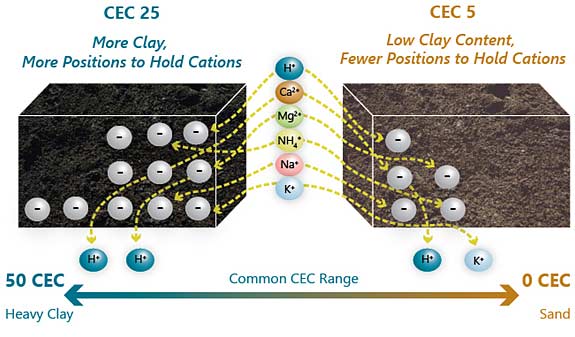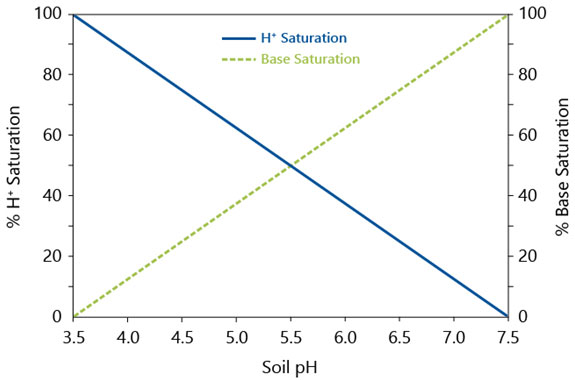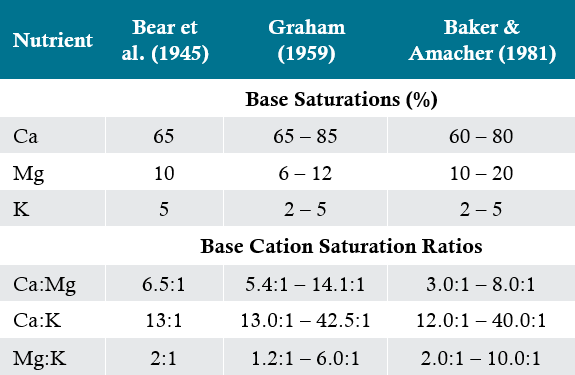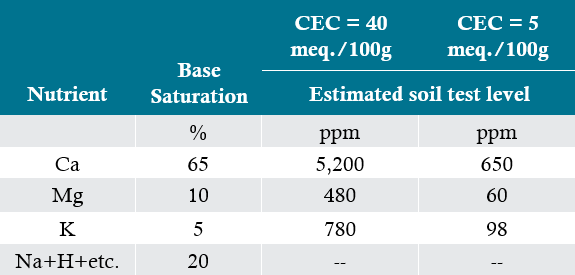To understand the theory behind the BCSR method or specifically, the Ca:Mg ratio, one must understand cation exchange capacity (CEC). Cations are positively charged ions in the soil solution (Ca2+, NH4+, Mg2+, K+, Na+, etc.). CEC is defined as the total amount of cations, in milliequivalents (meq), held to soil components through an electrostatic attraction, which can be exchanged with cations in soil solution. A specific soil’s CEC is dependent upon three main factors:
- The amount of clay (soil texture)
- Type of the clay
- Amount of organic matter (OM)
For this reason, the CEC of a given soil can vary from 0 to 50 meq/100g soil. Soils with a low CEC typically have a high sand fraction and low OM content, whereas soils with a high CEC have a relatively high clay fraction and/or OM content (Figure 1).

Figure 1. Depiction of the soil CEC. Adapted from Spectrum Analytics Inc.
Further knowledge of base saturation is critical to the BCSR method. Base saturation is the sum of base cations (Ca2+, Mg2+, K+, and Na+) held onto the soil exchange sites divided by the total CEC and expressed as a percentage. Base saturation can be described by Figure 2. For this reason, the amount of cations on the exchange sites will be limited as the soil pH decreases or becomes more acidic due to the increased amount of H+ ions on exchange sites and in soil solution.

Figure 2. Relationship between base saturation and H+ on the CEC across soil pH.
Base Cation Saturation Ratio
Advocates of the BCSR maintain that there is a ratio of basic cations (Ca2+, Mg2+, and K+) that must occupy the soil cation exchange sites or plant growth will be limited. Bear et al. (1945) suggested that the base saturation of the cation exchange complex should be in specific amounts of 65% Ca2+, 10% Mg2+, 5% K+, and 20% a combination of H+, Na+ and NH4+. This results in a base cation saturation ratios of 6.5:1 for Ca:Mg, 13:1 for Ca:K, and 2:1 for Mg:K, which is also expressed as 13:2:1 for Ca:Mg:K and has been termed the “ideal” ratio (Table 1).
Furthermore, Bear and his colleagues mentioned that there is likely a range in the amount of Ca2+, Mg2+, and K+ that can occupy exchange sites and still allow optimal crop growth. However, no such range was ever reported, and therefore, many soil testing labs took these values as absolute with no margin of error. Base saturation ranges were not reported until Graham (1959) did so and again by Baker and Amacher (1981). However, these ranges are completely based upon theory along with the work of Bear and his colleagues and not on actual field or laboratory experiments (Table 1).
Table 1. Previously reported base saturations and subsequent base cation saturation ratios (BCSR) for an “ideal” soil.

* Bear et al. (1945) is considered the "ideal" ratio.
The BCSR method focuses on keeping these three nutrients close to specific cationic ratios (Table 1) regardless of soil test values, soil type, crop, and yield potential. However, because the BCSR approach solely focuses on maintaining a specific ratio between Ca2+, Mg2+, and K+ (13:2:1), the amount of these nutrients in the soil can vary considerably depending upon the given soil’s CEC (Table 2) and actual base saturation (Table 4).
Table 2. Comparison of 2 soils with the same base saturations but different CEC and their approximate levels of calcium, magnesium, and potassium in the soil at the “ideal” ratio.

Table 3. Wisconsin soil test categories for calcium, magnesium, and potassium.

*From Laboski and Peters (2012)
Note: Larger View - Table 3.
Table 4. Comparison of two soils with the same CEC and “ideal” ratio of 13:2:1 of Ca:Mg:K but different percent base saturations and their approximate levels of calcium, magnesium, and potassium.

*Both soils are at the “ideal” ratio
Note: Larger View - Table 4.
Table 5. Ca:Mg ratio for various soil types throughout WI.

*From Schulte and Kelling (1985)
Note: Larger View - Table 5.
For example, a soil with a CEC of 5 meq/100g soil will contain approximately 1,300 lb/acre Ca (650 ppm) compared to 10,400 lb/acre Ca (5,200 ppm) in a soil with a CEC of 40 meq/100g, both at the same base saturation of 65% Ca (Table 2). While, these levels of Ca are not detrimental to plant growth, reaching this Ca base saturation for a high CEC soil can require large and expensive fertilizer applications. For instance, if the Ca:Mg ratio is initially 5.5:1 (55% Ca and 10% Mg) and the soil CEC is 40 meq/100g, there is roughly 8,800 lb/acre Ca.
Obviously, a soil with over 4 tons/acre Ca (4,000 ppm) is in excess supply, but the BCSR approach would recommend 3.6 tons/acre of gypsum to bring that soil to the “ideal” ratio of 6.5:1. At $40/ton of gypsum, this would cost approximately $144/acre on soil that is already excessively high for Ca (>1,000 ppm) as conveyed by the build and maintain approach (Table 3).
Another two soils with the same CEC, both at the “ideal” ratio, can have vastly different amounts of Ca, Mg, and K due to different base saturations of the cation exchange complex (Table 4). Displayed in Table 4 are two sandy soils with low CEC that are both at the “ideal” ratio; however, soil #2 with base saturations of 32.5% Ca, 5% Mg, and 2.5% K would contain less than optimal amounts of all three nutrients for crop production. The soil test levels would subsequently be 325 ppm Ca, 30 ppm Mg, and 49 ppm K (Table 3). All three nutrients would fall into the low-end of the low soil test category (Table 3) and, therefore, likely limit crop production even though the soil is at the “ideal” ratio. Furthermore, such a low saturation of the CEC with Ca, Mg, and K would likely lead to a pH well below 6.0 due to high saturation of H+ ions on the exchange sites (Figure 2).
Current recommendations would suggest an application of agricultural or dolomitic lime to correct the pH. Besides raising the pH, the lime application would also move the BCSR away from the “ideal” ratio but actually improves crop production due to a more favorable pH.